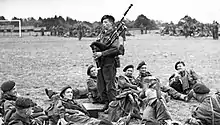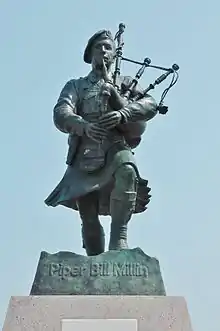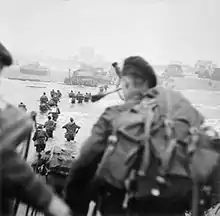Bill Millin
William Millin (14 July 1922 – 17 August 2010),[1] commonly known as Piper Bill, was personal piper to Simon Fraser, 15th Lord Lovat, commander of 1 Special Service Brigade at D-Day.
William Millin | |
|---|---|
 Bill Millin plays his pipes for fellow soldiers in 1944 | |
| Nickname(s) | Piper Bill |
| Born | 14 July 1922 Saskatchewan, Canada |
| Died | 17 August 2010 (aged 88) Torbay, England |
| Allegiance | |
| Service/ | |
| Rank | Private |
| Unit | |
| Second World War | Normandy landings at Sword |
| Other work | Psychiatric nurse |
Early life
Millin was born in Saskatchewan, Canada, on 14 July 1922 to a father of Scottish origin who moved the family to Canada but returned to Glasgow as a policeman when William was three. He grew up and went to school in the Shettleston area of the city. He joined the Territorial Army in Fort William, where his family had moved, and played in the pipe bands of the Highland Light Infantry and the Queen's Own Cameron Highlanders before volunteering as a commando and training with Lovat at Achnacarry along with French, Dutch, Belgian, Polish, Norwegian, and Czechoslovak troops.[2]
Second World War
Millin is best remembered for playing the pipes whilst under fire during the D-Day landing in Normandy.[4] Pipers had traditionally been used in battle by Scottish and Irish soldiers.[5] However, the use of bagpipes was restricted to rear areas by the time of the Second World War by the British Army. Lovat, nevertheless, ignored these orders and ordered Millin, then aged 21, to play. When Private Millin demurred, citing the regulations, he recalled later, Lord Lovat replied: "Ah, but that’s the English War Office. You and I are both Scottish, and that doesn’t apply." He played "Highland Laddie" "The Road to the Isles" and "All The Blue Bonnets Are Over The Border" as his comrades fell around him on Sword.[1] Millin states that he later talked to captured German snipers who claimed they did not shoot at him because they thought he had gone mad.[6]
Millin, whom Lovat had appointed his personal piper during commando training at Achnacarry, near Fort William in Scotland, was the only man during the landing who wore a kilt – it was the same Cameron tartan kilt his father had worn in Flanders during World War I – and he was armed only with his pipes and the sgian-dubh, or "black knife", sheathed inside his kilt-hose on the right side.[2]
Lovat and Millin advanced from Sword to Pegasus Bridge, which had been defiantly defended by men of the 2nd Bn the Ox & Bucks Light Infantry (6th Airborne Division) who had landed in the early hours by glider. Lovat's commandos arrived at a little past one p.m. at Pegasus Bridge although the rendezvous time in the plan was noon. To the sound of Millin's bagpipes, the commandos marched across Pegasus Bridge. During the march, twelve men died, most shot through their berets.[7] Later detachments of the commandos rushed across in small groups with helmets on. Millin's D-Day bagpipes were later donated to Dawlish Museum. A set of pipes he used later in the campaign, after the originals became damaged, were donated to the now "Pegasus Bridge Museum".[8][9]
Later life

Millin saw further action with 1 SSB in the Netherlands and Germany before being demobilised in 1946 and going to work on Lord Lovat's highland estate. In the 1950s he became a registered psychiatric nurse in Glasgow, moving south to a hospital in Devon in the late '60s until he retired in the Devon town of Dawlish in 1988.[6] He made regular trips back to Normandy for commemoration ceremonies. France awarded him a Légion d’honneur for gallantry in June 2009.[10] In 2006, a Devon folk singer, Sheelagh Allen, wrote a song about him, "The Highland Piper".[11]
Millin played the pipes at Lord Lovat's funeral in 1995.[12] Millin, who suffered a stroke in 2003, died in hospital in Torbay on 17 August 2010, aged 88.[1][4] His wife Margaret (née Dowdel, from Edinburgh) died in 2000. They were survived by their son John.[2]
Popular culture and legacy

Millin's action on D-Day was portrayed in the 1962 film The Longest Day.[4] Millin was played by Pipe Major Leslie de Laspee, the official piper to the Queen Mother in 1961.[13]
One set of Millin's bagpipes are exhibited at the Memorial Museum of Pegasus Bridge in Ranville, France.[14] Another set of his bagpipes are now displayed at Dawlish Museum.[15] Millin presented his pipes to Dawlish Museum prior to the 60th anniversary of the D-Day Landings in 2004, along with his kilt, bonnet and dirk. These items are still shown at the museum library with photographic archives and looped video telling of Millin’s exploits.[16]
Dawlish Museum officials have written testimony from Millin that the set on display in Dawlish is the genuine set which he played during the D-Day landings at Sword. The ones on show at the Pegasus Bridge Museum are a second set that were used by him later in the campaign, after the capture of Pegasus Bridge. Pegasus Museum says that it lays no claim to its set being the originals. Andrew Wright, vice chairman of Dawlish Museum, said:
The genuine pipes are here in Dawlish and not at Pegasus Bridge Museum in France, as everyone always seems to believe. I have tried to correct this many times but the myth continues and is always quoted in the media. The confusion arose many years ago when Bill's pipes were damaged a few days after D-Day and he had a spare set sent in which he called his campaign pipes. Those were given to Benouville Museum in 1974 and people assumed these were the original pipes.[8]
With the help of son John Millin and the Dawlish Royal British Legion, a bronze life-size statue of Piper Bill Millin was unveiled on 8 June 2013 at Colleville-Montgomery, near Sword, in France.[17][18]
On 7 August 2013, BBC's The One Show featured a film about Bill's son John Millin and his playing of the bagpipes in memory of his father at the unveiling of the statue to Piper Bill at Colleville-Montgomery in Normandy. Broadcast live, from Weston-super-Mare, Larry Lamb explained that Bill Millin's pipes and uniform are on display at Dawlish Museum in Devon. The film also showed scenes of more than 500 pipers from 21 countries taking part in the unveiling of the £50,000 statue by French sculptor Gaetan Ader which took more than four years of fund raising by the D-Day Piper Bill Millin Association to complete.[19]
Canadian Celtic-punk band The Real McKenzies recorded a song about Bill Millin ("My Head Is Filled with Music") on their 2012 album Westwinds. British folk band Police Dog Hogan refer to him in their song "Fraserburgh Train", from the 2012 album "From the Land of Miracles". Another recording in his honour, called "The Mad Piper", was made by the Swedish power-metal band Civil War on their 2015 album Gods And Generals.
See also
- Jack Churchill, another British Army bagpiper serving during the Second World War
References
- "Piper Bill Millin", Telegraph
- Davison, Phil (23 August 2010). "Obituaries: Piper Bill Millin: The 'Mad piper' who piped the allied troops ashore on D-Day". The Independent. Retrieved 25 May 2014.
- Arthur, Max (2004). Forgotten Voices of The Second World War, Random House, ISBN 0091897343, p. 317
- "Bill Millin, Scottish D-Day Piper, Dies at 88". The New York Times. 19 August 2010. Retrieved 20 August 2010.
Bill Millin, a Scottish bagpiper who played forbidden highland tunes as his fellow commandos landed on a Normandy beach on D-Day and lived to see his bravado immortalized in the 1962 film 'The Longest Day,' died on Wednesday in a hospital in the western England county of Devon. He was 88.
- "History and Heritage of Scotland". www.scotland.com – Scotland Channel. Retrieved 19 June 2017.
- "Bill Millin". The Economist: 76. 28 August 2010. Archived from the original on 6 June 2017. Retrieved 12 January 2010.
- Ambrose, Stephen E. (1994). D-Day, June 6, 1944: The Climactic Battle of World War II. Simon & Schuster. p. 570. ISBN 0-684-80137-X.
- Ellen Grindley (Reporter for the Dawlish Gazette) Dawlish Gazette.13 May 2015.www.dawlishnewspapers.co.uk
- "Bill Millin". The Economist. 26 August 2010. Retrieved 3 September 2012.
- Gall, Charlie (18 August 2010). "Brave Scot Bill Millin who played the pipes as bullets flew on D-Day beach dies aged 87". Retrieved 19 June 2017.
- "D-Day piper celebrated with song". news.bbc.co.uk – BBC News – UK – England – Devon. Retrieved 19 June 2017.
- https://www.independent.co.uk/news/obituaries/piper-bill-millin-the-mad-piper-who-piped-the-allied-troops-ashore-on-d-day-2059271.html
- "Dawlish D-Day veteran back in Normandy", The Herald, 6 June 2009,
- "La cornemuse de Bill Millin". www.memorial-pegasus.org. Archived from the original on 27 July 2011. Retrieved 19 June 2017.
- Mavis Stuckey (Dawlsh Museum Curator). Western Morning News. 18 August 2010.
- "A true British hero". Tindle Newspapers Ltd. 25 August 2010. Archived from the original on 4 September 2010. Retrieved 27 August 2010.
- Ellen Grindley Dawlish Gazette, 19 September 2012. Publisher Tindle Newspapers Ltd.
- "Colleville-Montgomery : inauguration de la statue de Bill Millin ce samedi matin". France 3. 8 June 2013. Retrieved 10 June 2013.
- Ellen Grindley, Dawlish Gazette 14 August 2013. Tindle Newspapers Ltd
External links
- Bill Millin talks about the landing on Sword
- Iconic piper sees French tribute, BBC News, Accessed 19 November 2009
- Pegasus Archive's page on Bill Millin
- The tribute to Bill Millin on the BBC's obituary programme, Last Word (2010 8 27), with excerpts from interviews with Millin, his son, and others who knew him
- John Millin pays tribute to his Father at the unveiling of his statue on YouTube, Dawlish Museum
- Imperial War Museum Interview
- Bill “The Mad Piper” Millin at Find a Grave
